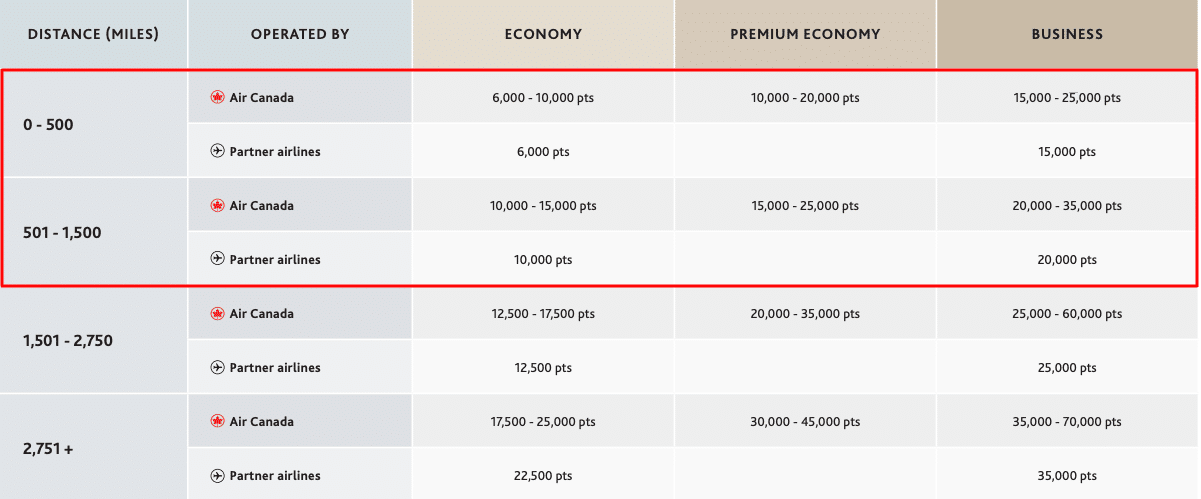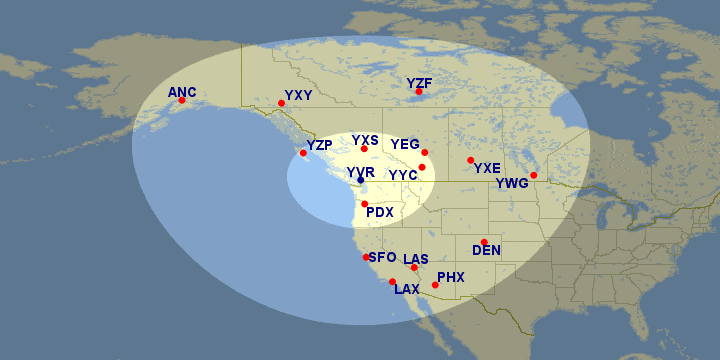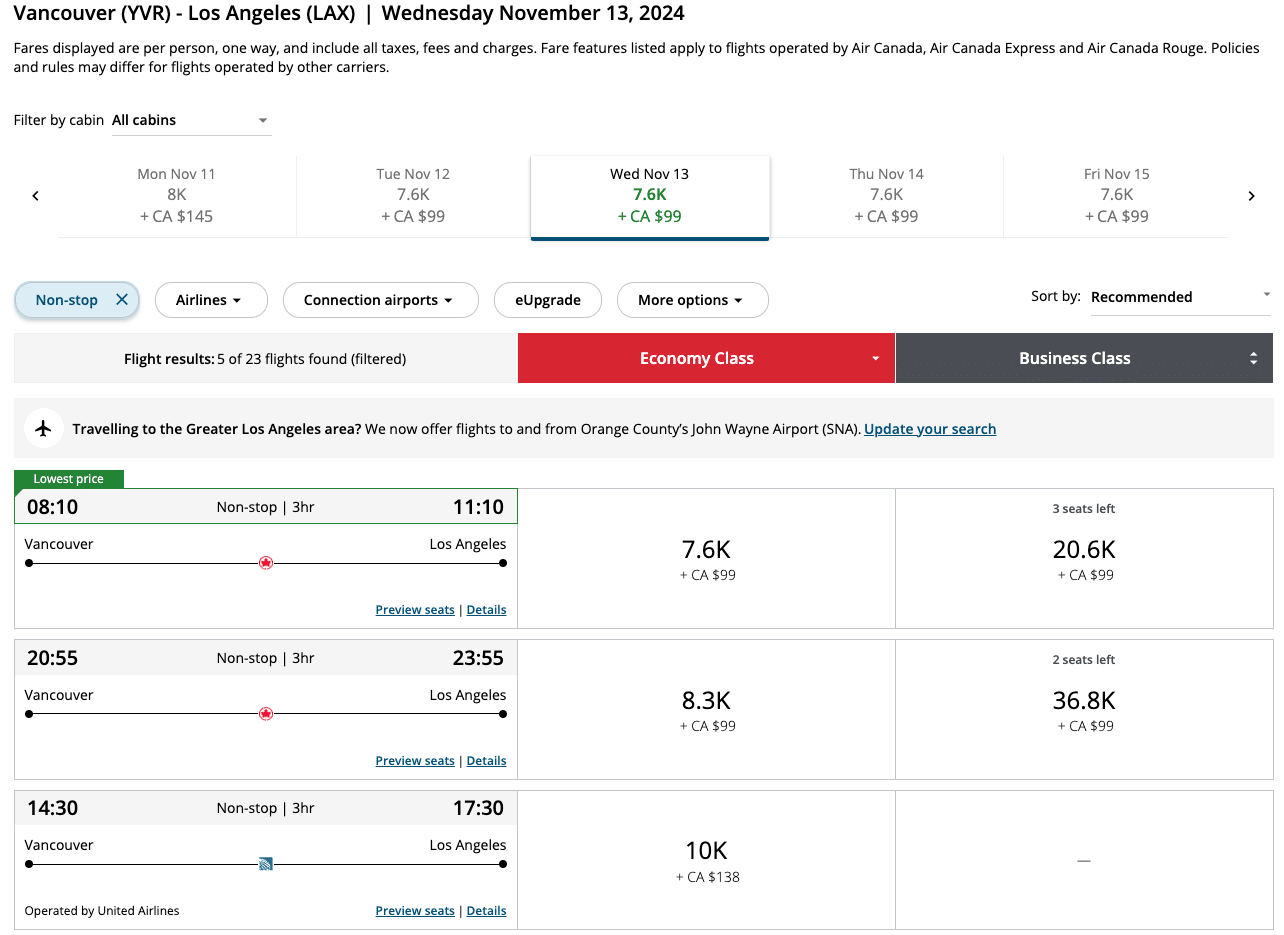Maximizing your Aeroplan points for short-haul flights is a great way to explore North America without dwindling your account balance too much. While long-haul flights often get the spotlight, short-haul options can be just as rewarding, opening up opportunities for quick getaways and spontaneous trips.
In this post, we’ll explore some fun and easy short-haul Aeroplan redemptions from Canada’s major hubs. Whether you’re after city escapes or outdoor adventures, these short-haul flights offer exciting travel options without costing too many of your hard-earned Aeroplan points.
In This Post
- Quick Recap on Aeroplan Flight Reward Chart
- Fun and Quick Short-Haul Flights From Canada
- From Toronto Pearson (YYZ)
- From Montreal (YUL)
- From Vancouver (YVR)
- From Calgary (YYC)
- From Halifax (YHZ)
- Conclusion
Quick Recap on Aeroplan Flight Reward Chart
As a reminder, the Aeroplan Flight Reward Chart divides the world into four zones: North America, South America, Atlantic, and Pacific.
In this guide, we’ll focus our attention specifically on the North America zone, which, in case you’re wondering, includes:
- USA (including Hawaii and Alaska)
- Canada
- Mexico
- Central America
- The Caribbean
When it comes to booking flights within this zone with Aeroplan points, there are four distance bands to note.
However, since we’re specifically looking at short-haul options, we’ll be focusing on the first two distance bands (or flights that are up to 1,500 miles in distance).
When looking for decent redemption value, we’ll aim to find flights that are priced towards the lower end of the dynamic range for flights with Air Canada and the fixed cost price in points for redemptions with partner airlines.
In the sections below, we’ll map out the chart’s first two distance bands from five Canadian hub cities using Great Circle Mapper to visualize which destination airports may fall within those ranges on non-stop flights.
On the maps below, the innermost band represents the first distance tier (0–500 miles), while the next band represents the second distance tier (501–1,500 miles).
Fun and Quick Short-Haul Flights From Canada
A short-haul flight typically refers to a flight covering a relatively short distance, generally coming in at around three hours or less of flying time. However, for this article, we’ll use the first two distance bands, which cover up to 1,500 miles, as our designation for what constitutes a short-haul flight.
These flights are perfect for quick trips and weekend getaways, offering lower points costs for travellers who want to maximize their miles on shorter routes. Short-haul flights make it easy to explore nearby cities, attend events, or simply enjoy a change of scenery without a long-haul commitment.
In the sections below, we’ll have a look at some example flights departing from each of the following cities: Toronto (YYZ), Montreal (YUL), Vancouver (YVR), Calgary (YYC), and Halifax (YHZ).
Keep in mind that not all the examples are meant to demonstrate the best possible redemptions or value; some examples simply highlight unique spots or are meant to showcase the range of possibilities available with Aeroplan points.
From Toronto Pearson (YYZ)
As Air Canada’s main hub, Toronto Pearson International Airport (YYZ) offers a wide range of short-haul Aeroplan redemption options across North America.
Within the first distance band, you’ll find cities like Ottawa, Montreal, Quebec City, Chicago, New York, Boston, and Washington, D.C.
The second distance band expands options to include Saskatoon, Regina, Halifax, and St. John’s, along with US destinations like Denver, Houston, New Orleans, and Miami.
This means that travellers departing from Toronto can enjoy quick escapes to both vibrant cities and scenic landscapes for minimal Aeroplan points.
First Distance band (0–500 miles)
One unique destination we recommend in this band is Sault Ste. Marie (YAM) – a spot not many people consider – where travelers often visit throughout the year for its natural beauty, scenic landscapes, and outdoor adventures.
While award flight prices from Toronto to Sault Ste. Marie often exceed the higher end of Aeroplan’s dynamic points range for this distance band, the cash prices for this flight generally hover around $300–400 (all figures in CAD), making this a great redemption opportunity despite the higher points price.
A highlight of Sault Ste. Marie is the Agawa Canyon Tour Train, especially popular during the fall foliage season. This all-day journey immerses you in the vibrant colours of the Canadian wilderness, with stunning views of rivers, lakes, and mountains along the way.
If you’re looking for an unforgettable autumn experience, redeeming your Aeroplan points for a trip to Sault Ste. Marie is a fantastic choice.
Second Distance Band (501–1,500 miles)
Interestingly, both Cuba and the Bahamas are included in this distance band as well – though, we’ll keep the focus on North American destinations for this article.
Our pick for this distance band is the hidden gem of Deer Lake, Newfoundland, a gateway to Gros Morne National Park, a UNESCO World Heritage Site known for its breathtaking landscapes.
Whether you’re hiking the Tablelands, soaking in the sweeping fjord views, or simply unwinding by a lake, this destination offers a serene and majestic escape.

Although award flights to Deer Lake tend to be priced closer to the upper limit of the Flight Chart’s dynamic range, the typical high cash price on this route makes this a prime candidate for acquiring excellent value from your Aeroplan points.
A flight from Toronto (YYZ) to Deer Lake (YDF) typically hovers around 14,900 Aeroplan points, while the cash price is usually around $339. This means that this redemption has a value of about 1.93 cents per point, which is pretty solid.
From Montreal (YUL)
Montreal-Trudeau International Airport (YUL) offers convenient short-haul Aeroplan redemption options across both Canada and the United States.
Within the first distance band, you can reach Canadian cities like Quebec City, Ottawa, and Toronto, as well as a few nearby US cities, perfect for quick getaways.
In the second distance band, flights from Montreal open up access to Atlantic Canada and a variety of US cities like Orlando, Fort Lauderdale, and Chicago.
First Distance Band (0-500 miles)
Flights to the cities in this distance band typically price out at 6,000–10,000 Aeroplan points, making them accessible for spontaneous getaways.
Unfortunately for those looking to take in some ceilidh music in the salty air, Halifax does not fall within this distance category, going just over the limit at 501 miles.
One of our top picks for this distance band is New York City, as no matter how many times you visit, there’s always something new to discover in the city that never sleeps. It’s perfect for lovers of metropolitan life and for foodies, with a culinary scene that ranges from iconic street vendors to Michelin-starred restaurants.

With multiple daily flights between Montreal (YUL) and New York City (NYC), you won’t find it too difficult to snag an award seat at the lower end of the dynamic price range.
Second Distance Band (501-1,500 miles)
Flights within this distance band typically prices at around 10,000 Aeroplan points for an economy redemption and 20,000 points for business class.
One standout destination in this band is Orlando, the theme park capital of the world. Whether you’re planning a magical day at Walt Disney World or chasing thrills at Universal Studios, it’s a family favorite that never disappoints.

Another reason we picked Orlando is because the city offers more than just theme parks; it’s a hub for family fun and adventure, and with frequent flights and a myriad of entertainment options, it’s an easy choice for a getaway.
Plus, despite being such a popular destination, flights to Orlando (MCO) can sometimes be found at the lower end of the dynamic point range, making it an attractive option for families. It’s a fantastic way to stretch your Aeroplan balance while creating unforgettable memories.
From Vancouver (YVR)
Vancouver International Airport (YVR) serves as a fantastic departure point for a variety of short-haul Aeroplan redemptions.
Within the first distance band, you can reach Canadian cities such as Calgary, Edmonton, and Prince George, as well as US destinations like Portland and Seattle, giving you lots of great options for quick weekend trips.
The second distance band opens up access to a wider range of cities, including Saskatoon, Winnipeg, Yellowknife, Whitehorse, and US cities like Los Angeles, San Francisco, Palm Springs, Phoenix, and Anchorage.
First distance band (0–500 miles)
All destinations in the first distance band should normally price out at 6,000–10,000 Aeroplan points for economy class with Air Canada, with the exception of one unique destination, Sandspit (YZP) located in Haida Gwaii, which appears to be consistently priced at around 18,000 Aeroplan points from Vancouver.
One of our favourite redemptions within this distance band is a flight from Vancouver (YVR) to Calgary (YYC) as it offers easy access to the Canadian Rockies, making it a great choice for both a city escape and an outdoor adventure.
With award flights generally available at the lower end of the dynamic range, it’s an exciting way to get more trips out of your Aeroplan points balance.

Second distance band (501–1,500 miles)
A couple locations of particular interest in the second distance band are the Californian hubs of Los Angeles and San Francisco, both great options for either for a coastal getaway or as a connection point to Asia for a First Class flight redemption, perhaps with Japan Airlines or All Nippon Airways.
Additionally, flights to Whitehorse and Anchorage offer great options for those looking to experience the Northern Lights.
One of our favourite redemptions out of Vancouver (YVR) is for flights to Los Angeles (LAX), with one-way economy awards showing for around 7,600 Aeroplan points, plus $99 in taxes and fees.

Los Angeles is a great destination for a Vancouver-based redemption, offering not only beaches and celebrity sightings, but also fantastic family-friendly fun at Disneyland.
So, whether you’re dreaming of a magical trip to the Happiest Place on Earth, a scenic drive up the Pacific Coast Highway, or planning a luxurious First Class hop to Asia, Los Angeles offers everything.
With frequent flights on this route, it’s relatively easy to work around your schedule to snag a low-cost redemption flight.
Plus, partner airline United Airlines also flies this route, meaning you can secure a flight for a fixed price of 10,000 Aeroplan points plus taxes and fees as long as there’s an available seat in economy class. This makes it especially compelling during peak times when Air Canada flights tend to surge in price.
From Calgary (YYC)
Calgary International Airport (YYC), despite being WestJet’s home airport, still offers a decent range of short-haul Aeroplan redemption options, perfect for quick escapes to Canadian and US destinations.
In the first distance band, travellers can reach nearby cities, such as Edmonton, Regina, Kelowna, and Vancouver, and the second distance band extends your options to include Winnipeg, Whitehorse, Yellowknife, and several US cities like San Francisco, Los Angeles, and Chicago.
These routes offer both scenic escapes and vibrant city experiences, suitable for any type of traveller.
First Distance Band (0 – 500 miles)
Our favourite redemption flight in this first band is to Kelowna. This short-haul route offers a great way to escape to the beautiful Okanagan Valley, known for its wineries, scenic lake views, and outdoor recreation.
Driving from Calgary to Kelowna can be challenging due to the mountainous and winding roads, which makes this quick one1-hour flight particularly appealing.

With one-way flights priced at around 8,400 Aeroplan points for economy class, Kelowna is a popular year-round destination, ideal for a stunning summer getaway or a winter trip to nearby Big White Ski Resort. However, the recent summers have seen some extreme heat waves and forest fire smoke, so make sure to check the weather before planning your trip.
Second Distance Band (501 – 1,500 miles)
For those who love city vibes, architecture, and art, consider using your Aeroplan points to fly to Chicago within the second distance band.
This bustling US city is known for its striking architecture (best viewed from a river cruise), deep-dish pizza, and the famous Cloud Gate (better known as “The Bean”), so whether you’re exploring Millennium Park, catching a Cubs game, or sampling the food scene, Chicago offers a rich city experience.

Aeroplan’s partner airline United Airlines operates a non-stop route from Calgary (YYC) to Chicago (ORD), with economy class priced at a fixed rate of 10,000 Aeroplan points. While the taxes and fees can be high on this route, this redemption may be worthwhile during peak seasons when flight prices typically surge.
From Halifax (YHZ)
Halifax Stanfield International Airport (YHZ) also provides excellent short-haul Aeroplan redemption options for exploring both Canadian destinations and nearby US cities.
In the first distance band, you can reach cities like Deer Lake, Sydney, and Boston, while the second distance band opens up access to Toronto, St John’s, and Orlando.
Whether you’re seeking an Ivy League educational hub or urban excitement, there are convenient routes out of Halifax to a variety of destinations.
First Distance Band (0 – 500 miles)
If you’re looking for a change of scenery from the Atlantic provinces while staying within the first distance band, consider flying to Boston (BOS), which offers a mix of history, culture, and academic inspiration. The city is rich with historic sites like the Freedom Trail and Beacon Hill, and it’s home to prestigious universities, including Harvard and MIT.
Whether you’re a parent hoping to inspire your children or simply curious to tour these renowned campuses, Boston provides a unique opportunity to explore one of the educational hubs of the US.

While this route falls within the first distance band, it’s consistently priced at around 15,300 Aeroplan points, which is above the typical upper limit for this band. With cash fares averaging $315, this redemption gives you a value of about 1.29 cents per point, which isn’t particularly good.
However, we included this route to highlight a US destination bookable within the first distance band using Aeroplan points.
So, if you’re looking to escape the Canadian landscape for a bit, and you’re not too worried about maximizing the value you get for your Aeroplan points, Boston is a solid option to consider.
Second Distance Band (501 – 1,500 miles)
In the second distance band, Halifax (YHZ) to Toronto (YYZ) is a prime route that opens up the vibrant experiences of Canada’s largest city. Toronto offers something for everyone: art enthusiasts can explore the Art Gallery of Ontario, food lovers will enjoy Kensington Market, and sports fans can catch a game at Scotiabank Arena.

For festival and concert enthusiasts, Toronto is a must-visit, with events happening year-round. Highlights include the Toronto International Film Festival (TIFF), which draws global attention each September, and the VELD Music Festival, a summer staple for electronic dance music fans.
This route typically costs 17,100 Aeroplan points for a one-way ticket in economy class, which is a moderate value at 1.39 cents per point, considering cash fare typically hovers around $290.
Conclusion
Aeroplan’s short-haul options make it easy to plan a quick and simple getaway without using up too many points.
Whether you’re drawn to the beautiful landscapes near Deer Lake, the outdoor adventures of Kelowna, or the historic charm of Boston, these short-haul routes offer accessible and memorable experiences for every traveller.
Without requiring a huge amount of points, you can explore diverse destinations across North America, perfect for a spontaneous escape or a well-deserved mini vacation.

































Is this information still relevant? Every time I have searched for flights with Aeropoints, the amount of points required has been 2-3x higher than what these tables say, and they don’t fall in bands but rather seem to be more expensive when the flight time is more desireable, etc. I can’t tell if I’m just searching very popular flight dates, or if Air Canada’s system has changed…?
Hello,
The information in this post is still relevant, as the Aeroplan Award chart has not been changed yet.
The reason the points required has been higher than it used to, attributes to dynamic pricing of Air Canada’s own flight.
Air Canada has stated that majority of their flights will fall within the range in the table, but not all.
A minority of flights will fall under the range, and some will go beyond the range.
The high points requirement is the result of high demand, or forecasted-high demand flights.
However, flights that fall below the range do exist.
Further, partner flights’ points requirement remains unchanged.
Albeit, some flights are not showing in Aeroplan as of late.
We are still waiting for Aeroplan to address those concerns.
Some sweet spots are difficult to book. I find it very difficult to book with some partner airlines to go to Central America like Avianca on the Air Canada website. There is no information about checked bagage… I suppose people would like to know before booking. Anyone had the same experience ?
Missing Asiana/Seoul.
Not worth redeeming for flights within Colombia, tickets in economy cost less than the value of the point cost plus the cash paid flight would earn points. Avianca is eliminating business class except for the European routes, and GOL does not have business. COPA short haul business is not worth it either.
Yes agree with Robert Hartley. The Atlantic/Maritime provinces are part of Canada. It is very frustrating to be totally ignored .
Hi Carole. The article has been updated with some information for our east-coast readers.
Tried 5 times to get a new aeroplan number and sign up but the system is so stupid I couldn’t make it happen
Good article but what about us folks living in the Atlantic region. You realize the world does not start and end in Toronto/ Montreal right?
We have updated the article with information relevant to our Atlantic-based readers. Thank you for pointing out my oversight.
Thank you for updating the article.
Great post, T.J.!
South America (along with Antarctica) is on my list, and this post has certainly given me a few ideas.
I’m wondering what your thoughts are around the best approach for someone in YYZ/YUL to get to HNL? I can only think of hoping to score a cheap positioning flight to YVR to make use of the 12,500 sweet spot, but don’t have high hopes for that, or any other plan. Better off to bite the bullet and book via AP YYZ/YUL-HNL?
I think if you can find tickets on the lower end of the dynamic range, flying from YYZ/YUL is still quite reasonable in economy or business. Unless you have a stash of Turkish Airlines Miles and Smiles (or Bonvoy points to convert to Miles and Smiles), of course 🙂
If you can find a deal on a low-cost carrier to get from Toronto to Vancouver, you could nest a trip to the west coast within your trip to Hawaii and hit the new Aeroplan sweet spot.
Swoop your way out from YHM-YXX for $69 🙂